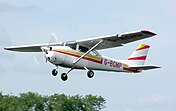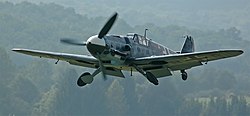Portal:Aviation
| Main page | Categories & Main topics |
|
Tasks and Projects |
The Aviation Portal

Aviation includes the activities surrounding mechanical flight and the aircraft industry. Aircraft includes fixed-wing and rotary-wing types, morphable wings, wing-less lifting bodies, as well as lighter-than-air craft such as hot air balloons and airships.
Aviation began in the 18th century with the development of the hot air balloon, an apparatus capable of atmospheric displacement through buoyancy. Some of the most significant advancements in aviation technology came with the controlled gliding flying of Otto Lilienthal in 1896; then a large step in significance came with the construction of the first powered airplane by the Wright brothers in the early 1900s. Since that time, aviation has been technologically revolutionized by the introduction of the jet which permitted a major form of transport throughout the world. (Full article...)
Selected article

Selected image

Did you know
...that a Fairchild C-119 Flying Boxcar was used in the 2004 film Flight of the Phoenix? ...that the Ryan X-13 Vertijet aircraft landed by using a hook on its nose to hang itself on a wire? ...that Yekaterina Zelenko was the only woman to perform an aerial ramming and the only female pilot in the Winter War?
General images -
In the news
- May 29: Austrian Airlines cancels Moscow-bound flight after Russia refuses a reroute outside Belarusian airspace
- August 8: Passenger flight crashes upon landing at Calicut airport in India
- June 4: Power firm helicopter strikes cables, crashes near Fairfield, California
- January 29: Former basketball player Kobe Bryant dies in helicopter crash, aged 41
- January 13: Iran admits downing Ukrainian jet, cites 'human error'
- January 10: Fire erupts in parking structure at Sola Airport, Norway
- October 27: US announces restrictions on flying to Cuba
- October 3: World War II era plane crashes in Connecticut, US, killing at least seven
- September 10: Nevada prop plane crash near Las Vegas leaves two dead, three injured
- August 6: French inventor Franky Zapata successfully crosses English Channel on jet-powered hoverboard
Related portals
Associated Wikimedia
The following Wikimedia Foundation sister projects provide more on this subject:
-
Commons
Free media repository -
Wikibooks
Free textbooks and manuals -
Wikidata
Free knowledge base -
Wikinews
Free-content news -
Wikiquote
Collection of quotations -
Wikisource
Free-content library -
Wikiversity
Free learning tools -
Wikivoyage
Free travel guide -
Wiktionary
Dictionary and thesaurus
Selected biography
Assigned as a P-40 pilot with the 45th Fighter Squadron of the 15th Fighter Group at Wheeler Field, Hawaii, 2nd Lt. Gabreski witnessed the Japanese attack on Pearl Harbor, but did not become airborne in time to engage the attackers.
In March 1943 Gabreski became part of the 56th Fighter Group, flying the P-47 Thunderbolt, and in May was promoted to Major and named commander of the 61st Fighter Squadron, which included six Polish nationals as pilots in 1944. He made his 28th kill on July 5, 1944, passing Eddie Rickenbacker's record from World War I to become America's top ace (although several pilots passed him by the end of the war).
Col. Gabreski flew combat again during the Korean War, as commander of the 51st Fighter-Interceptor Wing, piloting an F-86 Sabre. He was credited with 6.5 MiG-15 kills, making him one of seven U.S. pilots to be aces in more than one war (the others are Col. Harrison Thyng, Col. James P. Hagerstrom, Major William T. Whisner, Col. Vermont Garrison, Major George A. Davis, Jr., and Lt.Col. John F. Bolt, USMC).
He ended his career as a commander of several tactical and air defense wings, his last assignment being commander of the 52d Fighter Wing at Suffolk County Air Force Base in Westhampton Beach, New York.
Selected Aircraft

The Messerschmitt Bf 109 was a German World War II fighter aircraft designed by Willy Messerschmitt in the early 1930s. It was one of the first true modern fighters of the era, including such features as an all-metal monocoque construction, a closed canopy, and retractable landing gear. The Bf 109 was produced in greater quantities than any other fighter aircraft in history, with a total of 33,984 units produced up to April 1945. Fighter production totalled 47% of all German aircraft production, and the Bf 109 accounted for 57% of all German fighter types produced.
The Bf 109 was the backbone of the Luftwaffe fighter force in World War II, although it began to be partially replaced by the Focke-Wulf Fw 190 from 1941. The Bf 109 was the most successful fighter of World War II, shooting down more aircraft than any of its contemporaries. Originally conceived as an interceptor, it was later developed to fulfill multiple tasks, serving as bomber escort, fighter bomber, day-, night- all-weather fighter, bomber destroyer, ground-attack aircraft, and as reconnaissance aircraft.
The Bf 109 was flown by the three top-scoring fighter aces of World War II: Erich Hartmann, the top scoring fighter pilot of all time with 352 victories, Gerhard Barkhorn with 301 victories, and Günther Rall with 275 victories. All of them flew with Jagdgeschwader 52, a unit which exclusively flew the Bf 109 and was credited with over 10,000 victories, chiefly on the Eastern Front. Hartmann chose to fly the Bf 109 in combat throughout the war, despite being offered the use of the Me 262. Hans-Joachim Marseille, the highest scoring German ace in the North African Campaign, also scored all of his 158 victories flying the Bf 109, against Western Allied pilots.
- Span: 9.925 m (32 ft 6 in)
- Length: 8.95 m (29 ft 7 in)
- Height: 2.60 m (8 ft 2 in)
- Engine: 1× Daimler-Benz DB 605A-1 liquid-cooled inverted V12, 1,475 PS (1,455 hp, 1,085 kW)
- Cruising Speed: 590 km/h (365 mph) at 6,000 m (19,680 ft)
- First Flight: 28 May 1935
Today in Aviation
- 2012 – The Syrian Revolution General Commission claims that its forces have destroyed 61 Syrian government helicopters and planes, mostly while on the ground during rebel raids, and that the heaviest Syrian government aircraft losses occurred in August.[1]
- 2011 – In the same modified Yak-3U, William Whiteside sets an unofficial speed record for piston-engined aircraft in the under-3,000 kg (6,615-pound) category of 670 km/hr (416 mph) over the same 3-km (1.863-mile) course at the Bonneville Salt Flats.
- 2007 – Renowned WWII fighter pilot “Tex” Hill dies (b. 1916). Hill joined the Flying Tigers, an American volunteer group based in China during World War II. He shot down 18 1/4 enemy aircraft during the war.
- 2006 – A Cirrus SR20 flown by New York Yankees pitcher Cory Lidle and an instructor crashed into the Belaire Apartments in New York City.
- 2000 – Launch: Space Shuttle Discovery STS-92 at 19:17:00 EDT. Mission highlights: ISS assembly flight 3A: Z1 truss. It was the 100th Space Shuttle Mission.
- 1999 – 1999 Air Botswana incident occurred when Chris Phatswe, a Botswana airline pilot, committed suicide by crashing a plane into the tarmac and a group of aircraft at Sir Seretse Khama International Airport in Gaborone. His actions effectively crippled operations for Air Botswana.
- 1998 – A Congo Airlines Boeing 727 is shot down by rebels in Kindu, Democratic Republic of the Congo, killing 40.
- 1991 – The crash of a Beechcraft T-34C Turbo-Mentor in Baldwin County, Alabama, kills Navy Cmdr. Duane S. Cutter, 44, from Newfield, New York, and his student, Marine 2nd Lt. Thomas J. Gaffney, 24, of West Chester, Pennsylvania, while on a routine training mission out of NAS Whiting Field, Florida, said Lt. Cmdr. Diane Hooker, a Navy spokeswoman at Whiting Field. Hooker couldn't immediately say what techniques the two were practicing when the T-34 went down.
- 1990 – First flight of the Rockwell-MBB X-31
- 1988 – KC-135 refueling tanker crashes on landing at Wurtsmith AFB, Michigan. Plane is destroyed and there are several fatalities.
- 1984 – Kathryn D. Sullivan becomes the first American woman to perform spacewalk aboard the Space Shuttle Challenger.
- 1984 – After a ground controller falls alseep on duty, Aeroflot Flight 3352, a Tupolev Tu-154, strikes several maintenance vehicles and crashes while landing at Omsk Tsentralny Airport in Omsk in the Soviet Union, killing 174 of the 179 people on board and four people on the ground.
- 1983 – Air Illinois Flight 710, a Hawker Siddeley HS 748, crashes near Hillsboro Municipal Airport due to electrical problems. All 10 passengers and crew on board are killed.
- 1968 – Apollo program – NASA launches Apollo 7, the first successful manned Apollo mission, with astronauts Wally Schirra, Donn F. Eisele and Walter Cunningham aboard.
- 1968 – Fifth prototype U.S. Navy Grumman F-111B, BuNo 151974, c/n A2-05, crash landed at Point Mugu, California. Scrapped. Navy abandons the F-111B program completely and both houses of Congress refuse to fund production order in May 1968.
- 1963 – The Vertol CH-113 Voyageur helicopter entered RCAF service.
- 1962 – First of 200 Canadian-built CF-104 Starfighters left for West Germany; to join strike-reconnaissance squadrons.
- 1960 – The Hon G. R. Pearkes, VC, DSO, retired as Minister of National Defence and was replaced by the Hon Douglas Harkness.
- 1957 – On takeoff shortly after 0000 hrs. from Homestead AFB, Florida, a Boeing B-47B-35-BW Stratojet, 51-2139, c/n 450192, of the 379th Bomb Wing, participating in exercise Dark Night, suffers port-rear wheel casing failure at 30 kts. The bomber's tail hits the runway and a fuel tank ruptures, crashing in an unhabited area approximately 3,800 feet from the end of the runway, four crew KWF. The aircraft burns for seven hours after the firecrew evacuates the area, ten minutes after the crash. The aircraft was carrying an unarmed nuclear weapon in the bomb bay and fuel capsule in a carrying case in the cabin. "Two low order detonations occurred during the burning." The nuclear capsule and its carrying case were recovered intact and only slightly damaged by heat. Approximately one-half of the weapon remained. All major components were damaged but were identifiable and accounted for.
- 1956 – A Vickers Valiant of No. 49 Squadron RAF drops Britain's first air-dropped atomic bomb, over Maralinga, South Australia
- 1944 – 61 carrier aircraft of Task Force 38 attack Aparri airfield on Luzon against no opposition, destroying about 15 Japanese aircraft on the ground in exchange for the loss of one U. S. plane to enemy ground fire and six to non-combat causes.
- 1938 – First flight of the Westland Whirlwind (fighter)
- 1933 – First flight of the Blackburn Perth
- 1928 – The Zeppelin LZ 127 Graf Zeppelin crosses the Atlantic in 71 hours.
- 1922 – First flight of the Navy-Wright NW (AKA Mystery Racer)
- 1919 – Handley Page Transport begins offering the first in-flight meals, on its London-Brussels service. They are sold at 3 s.
- 1918 – The Imperial German Navy’s air command proposes that merchant ships be converted into Germany’s first aircraft carriers with flight decks.
- 1910 – Theodore Roosevelt (President of the United States of America 1901 – 09) becomes the first former state leader to fly (four minutes) in an airplane when he flies with exhibition pilot Arch Hoxsey in a plane built by the Wright Brothers at Kinloch Field in St. Louis.
- 1907 – Robert Esnault-Pelterie makes the first airplane flight with a control stick, using a single, broom handle-like lever.
References
- Shortcuts to this page: Portal:Airplanes • P:AVIA




















































